Deepwater Production
Scale management and risk assessment for deepwater developments
Decision tree analysis and simple economic models identify technical option ranking and project-cost estimates for full field life
Ian Collins, BP Exploration Operating Co., UK
Inorganic precipitates (scales) are one of the major flow-assurance concerns in offshore oil/gas production. Such deposits have the potential for causing severe productivity impacts and can significantly influence lifting costs because of associated intervention costs. While scale control in conventional, shallow-water developments is reasonably mature, deepwater production brings with it a number of additional challenges to the control of inorganic scale. These center mainly around the high costs associated with intervening in deepwater wells, and the challenging infrastructure that such developments are adopting, i.e., highly deviated subsea wells.
Because the cost of getting scale management wrong is so high for deep water, increased rigor is required for scale prediction, risk assessment and management for such developments. Discussed herein are methods to assess the risk of scale formation and the applicability/cost-effectiveness of various scale management options, focusing principally on decision tree analysis.
INTRODUCTION
The increasing number of subsea fields, together with deepwater production, raises particular issues and evolving challenges for flow assurance beyond those seen for simple, vertically drilled wells.1 – 3 For typical deepwater development scenarios, the cost and technical difficulty of constructing platforms to develop these reserves is making the option of subsea wells an increasingly popular choice. The wellheads are often located on the seabed, with flowlines to a riser that carries the production up to a vessel, such as an FPS, or to a platform in shallower waters.
The complexity of new completions in terms of horizontal and multi-lateral wells, subsea tiebacks and commingled flow present particular flow-assurance challenges. With increasing use, seawater injection for reservoir support and secondary recovery will add mineral-scale deposition to the list of problems. Indeed, scale formation will be the critical flow-assurance risk for many developments. Where inhibitor treatments are required for such complex wells, they are often associated with high intervention costs.
Scale-control issues need to be addressed as part of asset life-cycle management, whereby the issues are tackled before field development, instead of when water breakthrough occurs.4 Indeed, the anticipated problems may influence development plans, e.g., water injection strategies or implementing appropriate technology upon well completion.
Scale control within life-cycle management is based on varying challenges seen as a field moves from dry production to high watercuts, Fig. 1. This is associated with four phases of development – project, plateau, decline and decommission.4 At the project stage, scale-control treatment strategies can be developed. The scale issues at subsequent stages depend on nature/severity of the anticipated problem.5 – 7
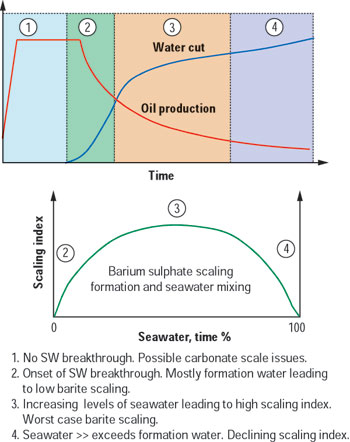 |
Fig. 1. Schematic of scale challenges through a field or well life cycle during secondary recovery via seawater injection.
|
|
One class of issues is associated with natural depletion, where consequent scale problems are normally restricted to calcium carbonate formation. Carbonate scale occurs when connate or aquifer water passes through the bubble point and carbon dioxide is evolved. In contrast, reservoirs that are flooded with seawater to provide reservoir support often form a more pernicious type of scale. This scale occurs when indigenous water (which is often rich in divalent cations such as barium) mixes with injection water (which for seawater is rich in sulfate) forming hard, insoluble sulfate scales.
Mixing seawater with formation water is complex, Fig. 2. Mixing of water near the injection wells or in the reservoir does not cause operational problems, as the volume of scale precipitated is small compared with the available volume. The critical area is in and around the producing well after waterflood breakthrough, where formation or aquifer water mixes with seawater, often from different sections of the wellbore, and barium sulfate precipitates. The kinetics of the reaction mean scale can precipitate anywhere from the near-well formation to the topsides.
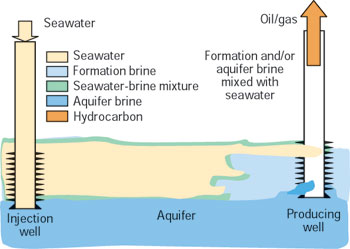 |
Fig. 2. Mechanism for mixing reservoir and injected waters.
|
|
Although all scales can impact production and well operation, barium sulfate scale is of particular concern. Over time, flow paths are obstructed and this highly insoluble precipitate requires mechanical removal to restore performance. Given the position of accumulations, this can prove expensive, difficult and, in many cases, impossible, requiring sidetracking or well replacement.
| |
Difficulty factor associated with deploying treatments into wells with different access and completion types |
|
| |
Access |
Well type |
Difficulty
factor |
|
|
|
|
| |
|
Platform |
1 |
|
| |
|
Subsea, dry tree |
1.5 |
|
| |
|
Subsea, wellhead |
3 |
|
| |
Completion |
|
|
|
|
|
| |
|
Cased and perforated, vertical |
1 |
|
| |
|
Cased and perforated, highly deviated |
1.5 |
|
| |
|
Cased and perforated, gravel packed. Short interval |
1.5 |
|
| |
|
Cased and perforated, gravel packed. Long interval |
2 |
|
| |
|
Short OHGP, low-angle well |
2.5 |
|
| |
|
Long OHGP, high-angle well |
4 |
|
|
Mechanism for mixing reservoir and injected waters. Essentially there are two water-injection scenarios: aquifer and oil-leg injection. Production wells receiving pressure support by oil-leg injection are expected to experience scaling for a more protracted period, and the entire length of each well will need to be protected fairly uniformly owing to widespread distribution of the maximum scaling regime. This is caused in part by spreading of the injected seawater through the oil leg, so that seawater is present at lower concentrations for longer periods, creating the greatest scaling potential.
This is in contrast to fields where injection is into the aquifer because, in the aquifer, 100% of the pore space is initially occupied by brine. This means that a unit volume of pore space in the aquifer will contain 20 times the mass of barium ions as a unit volume of pore space in the oil leg. Consequently, one would expect a greater mass of deposited scale in the aquifer. However, the amount of time that the scaling brines are in contact with one another at low-seawater concentrations will increase the amount of scale deposited and, hence, producers supported by oil-leg injection wells – particularly those close to the edge of the field where fluids are moving the slowest – may need to be treated most regularly.
As the wells within a field move from dry production to high watercuts, the life-cycle management challenges for scale control change. This is associated with the four phases of field development – project, plateau, decline and decommission.
Scale impact through project life cycle. At the project stage, control treatment strategies can be developed. The scale issues at subsequent stages depend on nature/severity of the anticipated problem.
Potentially, the major factor in inorganic scale control relates to production-systems design to allow cost-effective access for chemical treatments during production life. In general, scale control by chemical inhibition remains achievable with current inhibitor chemistries. However, costs associated with treatment in deep water, especially for downhole squeeze treatments, may be orders of magnitude higher than for conventional systems. For example, subsea templates may make conventional squeeze treatments less economic owing to lost productivity from all wells for a single treatment. The potential requirement for selective treatments using ROVs, and the additional expense incurred, again impose a significant economic burden on total operation cost.
Individual seabed flowlines, even individual chemical umbilicals to each well, may be similarly uneconomic owing to additional capital expenditure. For squeeze application, effective placement is essential and ever-more challenging in complex subsea production systems to ensure long squeeze lifetimes. More effective chemicals and delivery packages are also important to maximize squeeze lifetimes.4
PREDICTING THE PROBLEM; EVALUATING PROJECT RISK
The investment associated with subsea wells and flowlines, and the difficulty in treating these wells, means that up-front risk assessment at the development stage is crucial. For example, the deepest wells in the Gulf of Mexico cost up to $100 million, with insulated flowlines costing around $1 million/mile. If potential production losses due to scale build-up are also taken into account, scale-management performance should be seen in terms of the value of oil and infrastructure protected, rather than just the cost incurred.
Scale-prevention strategies have conventionally relied on a prediction of the possible scaling regime (maximum precipitation and supersaturation) based on brine compositions, temperatures and pressures. And, until recently, little effort has gone into identifying how the problem will evolve with time, and how it will vary depending on location in the reservoir. Advances are being made in this regard, largely owing to the need for advanced planning in deepwater and satellite developments,4 which will have a significant impact on up-front exposure to increased expenditure.
To evaluate project risk for sulfate scale, if it is assumed that current scale-inhibitor chemistries will be successful, then the question becomes: Can scale inhibitors be deployed and, if so, will the treatment lifetime be economic? The answer to this question should be assessed on both the basis of current squeeze/scale control technology and new technology. The economics of these strategies, if found feasible, should then be compared with the economics of using desulfated seawater in the waterflood. However, owing to a remaining 40 ppm of sulfate in desulfated water, this still requires some form of scale control; and the sulfate level must be reduced to <10 ppm to eliminate barite scale entirely from the whole production system.8 – 10
The following process should help to accurately determine the risk that scale poses: 1) obtain representative water chemistries for input into field development; 2) assess the magnitude of the scale problem; and 3) review possible control processes (completion design, chemical squeeze, sulfate reduction, etc.).
The components of this process are:
- Sample acquisition. Ensure that good-quality, representative samples are obtained (preferably downhole) that are correctly stabilized
- Key component analysis. Perform 10-ion analyses with accurate measurement of bicarbonate ion concentration and volatile fatty acid content
- Expert review of the water chemistry data
- Determine whether there has been any sample contamination with drilling muds/completion fluids, etc.
- Predict scale using a recognized simulation package
- Assess the nature of scale and the mass predicted
- Review the development and determine which scale-control technologies might be appropriate.
To simplify the initial scale-risk assessment, it is useful to broad band the risk into five categories. These are based on the scaling tendency or Super Saturation Ratio (SSR) calculated for the brines assessed. The five SSRs and associated scale risk, in parentheses, are: 3 – 29 (1); 30 – 99 (2); 100 – 199 (3); 200 – 299 (4); and 300+ (5).
To be effective, scale-inhibition must be successfully deployed. The difficulty of deploying scale inhibition technology is a function of the type of development, e.g., water depth, position of the wellheads, and of the well (type and completion).11 – 12 As a recommended method of characterizing severity of scale-inhibitor deployment issues, a deployment (well intervention) index has been calculated, based on industry experience, which ranks the difficulty of performing a squeeze treatment and successfully placing chemical. The index is a composite of two factors encompassing: 1) the difficulty of well access; and 2) nature of the completion. Numerical values assigned to these factors are outlined in the accompanying table. The overall intervention difficulty, or index, is taken as both factors multiplied together, giving a scale of 1 to 12.
A range of BP and industry data has been compiled and plotted in the form of a risk matrix of scale risk against intervention difficulty, Fig. 3. It is clear from this data that the upstream industry will face great challenges in the future in attempting to control downhole scale by intervention-based scale-control technologies. New technologies can impact this area by providing longer-life treatments. The value of all treatments should be quantified in terms of $/bbl of oil protected to ensure that treatment costs are not exceeding oil lifting costs.
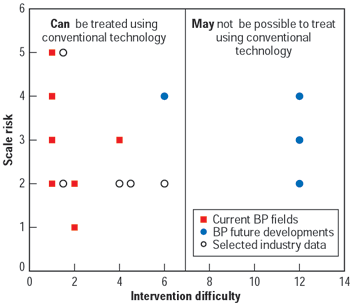 |
Fig. 3. Risk of scale formation impacting production, vs. intervention difficulty for existing BP fields, selected industry data and future BP developments.
|
|
DECISION TREE ANALYSIS FOR SCALE RISK
BP has developed a decision tree-based process (that runs within Microsoft Excel) that encapsulates the above arguments and effectively automates the process of defining project options for scale management.13 – 15
The assessment of scale risk has two parameters which need quantified: 1) the probability of the (uncertain) event, i.e., scale formation; and 2) the consequences of the event. The probability is expressed as a number between 0 (no chance of occurrence) and 1 (certain), and is linked to each of the possible consequences. Events in this case are the occurrence of and type of scale. Consequences in this application are as follows: wellbore damage or total loss; production downtime; treatment costs; and/or damage-remediation costs.
Values need to be assigned to each probability/ consequence pair with the risk being the product of the probability and the consequence value. It is important to remember from the outset that the principle of garbage in, garbage out applies to risk assessment.
Decisions are also treated as events; however, they are events chosen by the user. They do not have probabilities assigned, they either happen or they don’t. Decisions do have consequences, and these are assigned values, such as the cost of implementing the decision. An example is the decision to squeeze treat a well at a cost of $100,000. This does not include any of the potential outcomes of the squeeze, which are uncertain, e.g., successful prevention of scale or wellbore damage, which will carry their own risks, i.e., probability x cost product. An example of the input page for the decision tree package is shown in Fig. 4, and a typical tree output is shown in Fig. 5.
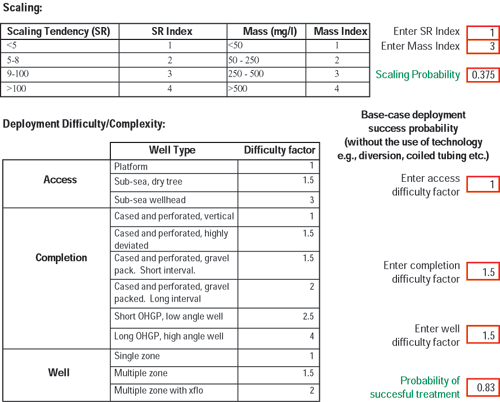 |
Fig. 4. Data input page for scale-risk, decision-tree package.
|
|
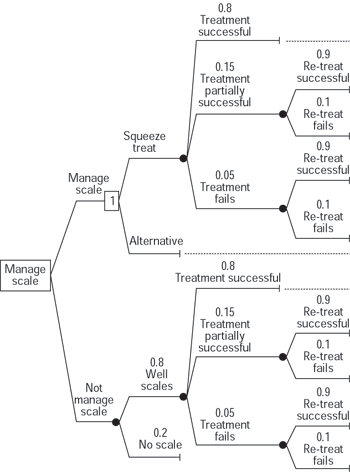 |
Fig. 5. Decision tree output page.
|
|
The decision tree describes the most significant difference between two outcomes. In the event of sulfate scale, the cost of deferred production can be avoided by performing the study up-front. Whether the operation is worth it depends on the probabilities assigned to each outcome. The probabilities of scale formation and of treatment success calculated by the decision tree spreadsheet are determined on the basis of lab data and operational experience. They are not absolute values and are subject to review and revision.
The cost of following each outcome of the decision tree and each outcome of the uncertain event (the end point cost) is multiplied by the probability of each uncertain event (the end point probability) to give the risked cost. For each branch of the decision tree, these products are summed to give the expected cost of each decision outcome. Expected cost is risk-weighted, which is useful for comparing decision alternatives. It is not to be confused with the actual outcome, which will be any one of the end-point costs of the decision tree. When there is more than a single uncertainty or decision, the uncertainties need to be placed in the correct order. The convention is to place the decisions and risks in the order they are resolved.
CONCLUSIONS
Effective scale management should encompass two essential processes: risk assessment and economic evaluation. Scale-management risk assessment allows the severity of any predicted mineral scales to be reviewed against current and future field development options. This allows current and near-market scale management technologies to be objectively assessed and ranked, allowing scale management options to be identified. By using decision tree analysis, scale management options can be ranked for a given development scenario. And by incorporating simple economic models of the full life-of-field cost of scale management within the decision tree process, the various technology options identified in the risk assessment phase can be ranked.
This allows decisions to be made on the choice of both hardware development options and scale management options during the project phase of a development. This, moreover, allows more cost-effective scale management solutions to be identified, and justified, during the production phase a field; i.e., the risk and economic aspects of scale management should be employed throughout a field’s life cycle.
Decision and risk analysis is a valuable tool for ensuring that all factors are considered for deepwater scale management. It is not a totally automated process, and depends on essential engineering expertise.
Note: The topics covered in this article were presented by the author at the conference, “Flow Assurance: A Holistic Approach,” London, October 29 – 30, 2002. 
LITERATURE CITED
Please visit our website at www.worldoil.com for references.
THE AUTHOR
|
 |
Ian Collins, senior production chemist in BP’s E&P Technology Group, holds a BSc in chemistry and a PhD in colloid science from the University of Bristol, UK. He joined BP Exploration in 1994 from BP Research, where he was involved in colloid science research. He has a global consulting role in scale management and is leading several technology projects in scale control and management. He has authored or coauthored more than 50 technical publications.
|
| |
|
|








